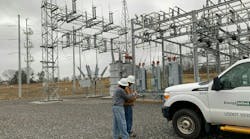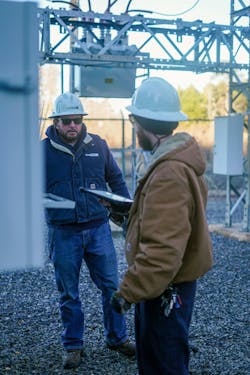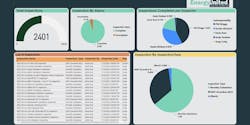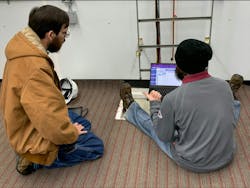Technology is often hailed as the great arbiter for working smarter instead of harder. But for EnergyUnited’s technical services team, the paperless system that used to be in place delivered the opposite effect — creating more work, not less. The technology was not bad, per se, but ultimately — having been adapted from another solution — it did not deliver as expected or needed. The result was a laborious, inefficient process.
So, when the cooperative decided to abandon the previously implemented technology used for substation inspections in favor of its old paper-driven processes, it became clear help was needed.
Back To Square One
Its return to paper processes was not a case of the coop being technologically averse. With roots back to the late 1930s, EnergyUnited differs from the coop it used to be. Formed in 1998 following the merger of Crescent Electric Membership Corp. and Davidson Electric Membership Corp., EnergyUnited’s footprint in North Carolina now stretches across the state, serving 19 counties.
While still primarily rural, the coop has experienced increased suburban growth and is the largest of the 26 electric coops in North Carolina, with over 12,000 miles (19,312 km) of distribution overhead and underground lines, 199 miles (320 km) of transmission lines, 71 substations and 11 12.5-kV delivery points.
The challenges EnergyUnited faced with its original paperless system had little to do with using technology and everything to do with having the right technology. An initial paperless process that should have streamlined substation inspection reporting instead created organizational challenges that, in the words of author Aldous Huxley, felt like this: “Technological progress has merely provided…a more efficient means for going backward.”
A Promise That Did Not Deliver
EnergyUnited’s technical services team oversees the construction, maintenance and repair of substations and downline equipment as well as maintains inspection sheets and equipment information generated from substation inspections.
Unfortunately, problems with extracting and reporting data emerged shortly after initial attempts to incorporate paperless substation inspection forms began. The primary issues were threefold:
- Platform failures led to inspection data loss. Inspection data, completed offline on tablets and then uploaded once technicians returned to the office, often was lost to upload failures. Once uploads began, the paperless platform automatically deleted data sheets from the system, regardless of whether an upload was successful. Upload failures resulted in data loss and, because the information was unrecoverable, a technician could lose an entire day’s work.
- Completion date variances required manual overrides. Extracted inspection data is based on the date of completion within a month. Utilities run at month end to transfer inspection data into a spreadsheet, which is then used for monthly reporting. However, the system being used did not allow for timing variances. For example, if technicians got an early start on scheduled monthly inspections (before the 1st of the month), the utility would not pick them up, meaning that month’s data would be skewed. There was no way to easily incorporate completion variances. Every month required time with IT to figure out how to tweak the utility and extract all the inspection data.
- The application was inflexible. The system offered no internal flexibility to modify inspection sheets to keep up with substation changes. Therefore, software modifications were difficult and expensive, each time requiring quotes from the vendor and internal approvals to spend money on updates.
These issues created an organizational ripple effect that made reporting difficult at best and inaccurate at worst. To prevent continued data loss and regain flexibility, EnergyUnited abandoned its paperless process and returned to capturing inspection data using paper.
Seeking Solutions
EnergyUnited’s return to paper was out of necessity — but temporary. The manual process enabled the utility to make changes, but it was highly inefficient and labor intensive. Inspecting technicians printed over 100 inspection sheets each month, hanging on to each one until all inspections were complete, and changes to substations or downline reclosers required manual updates.
Engineering manually entered inspection data into the monthly substation report spreadsheet; inspection sheets were scanned and kept for one year.
In addition to monthly substation reports, EnergyUnited relied on spreadsheets to maintain equipment lists and information like trip settings and meter multipliers. Because each of these was kept on separate spreadsheets (and in various places), sometimes it was challenging for coop staff to locate relevant data.The return to paper inspections was a stopgap, but a more viable solution was needed. Realizing change was necessary, EnergyUnited began searching for a new solution.
The Power Of Connection
Ultimately, old-fashioned networking provided a lead on potential software. A neighboring utility was successfully using a cloud-based platform for substation inspections, and EnergyUnited reached out to the vendor, MinMax Technologies, for a demonstration.
By this time, co-op leaders felt they were on the cusp of progress with a solution in sight that would bring flexibility, accuracy and efficiency to the inspection process.
After vetting three companies, MinMax Technologies’ eSMART system was selected for three main reasons:
- The platform is designed specifically for equipment tracking and substation inspections with flexibility that would enable the utility to make internal updates.
- Installation and integration would not require extensive IT expertise yet offered ample capability.
- The solution would allow for customization, with inspection questions and custom data fields to store information not already contained elsewhere, and equipment selection would be at the utility’s discretion.
Focus On Principles
The MinMax technology allows EnergyUnited to keep its focus on the key pillars of its business model: reliability, resilience and safety. By automating these critical processes, coop employees gained back time for writing inspection questions and adding equipment data with technicians.
As EnergyUnited began implementing the new platform, opportunities for efficiency emerged. The software enabled the utility to track equipment (before, this was done solely by spreadsheets) and have a more efficient process for managing warranties, installations, testing, removals and maintenance. Data remains centrally housed, but secure access is available, whether in the field or at the office.
Path To Automation
As EnergyUnited embarked on implementation, the utility had three primary objectives:
- Roll out a paperless substation inspection process that did not lose data
- Allow updates to be made internall
- Use the software’s asset management and work order generation capabilities.
Data loss was a primary concern, given the utility’s previous history with paperless inspections. However, this concern was quickly assuaged because the MinMax solution does not delete inspection sheets during uploads.
For EnergyUnited, the hardest part of the implementation process was planning and gathering information, which included documenting equipment at each substation and deciding on naming conventions. However, once those tasks were complete, bulk imports of substation and equipment data simplified the remaining steps.
Two things helped to smooth the process:
- Robust training database — A training database includes a practice environment where users can try different formulas and inspections before making changes to the production database. Taking full advantage of that feature helped to ensure everything was set prior to production.
- Knowledgeable staff and support — The MinMax staff was responsive, knowledgeable, easily accessible and available to help with issues and training.
From Frustration To Function
For two years now, EnergyUnited’s engineering and technical services departments have been using the eSMART asset management system, specifically the online subscription service. With it, these teams have reduced paperwork and streamlined asset management.
After implementing the system, the coop has become more efficient in its substation inspection process. Gone are the days of printing paper inspection sheets, manually entering inspection data and scanning sheets for long-term storage. Now, everything is digital and manual recordkeeping is, once again, a thing of the past. As a result, substation technicians now can quickly generate inspection sheets, and the data they collect — such as meters, amps and indicator readings — automatically goes into substation reports.
Substation equipment and downline reclosers are tracked easily. Technicians can attach photos to inspections and equipment, and the team leader no longer has to manually process and scan more than 125 inspections each month. Not to mention, this digital process also has reduced frustrations caused by hard-to-read handwriting and general human error.
When issues are found during inspections, technicians take photos of the abnormality to include and access in the report. Additionally, relevant equipment documentation, schematics, photos of nameplates and other testing data are attached to inspections and equipment.
Benefits All Around
Moving to a comprehensive, cloud-based platform has saved EnergyUnited time and money, maximizing human capital while better stewarding available resources.
Field personnel have benefited in the following ways:
Substation technicians can easily see previous readings — voltage, amps and demand — and how many operations each piece of equipment had, giving them a more comprehensive view of the system and equipment.
Trends and abnormal conditions are more easily spotted. With equipment locations uploaded, the system automatically captures temperature data for the date and time an inspection was completed.
Leadership also has benefitted in several ways:
- It is now easy to spot trends and create graphs for monthly reporting.
- It integrates well with Power BI for additional customization.
- MinMax staff provides ongoing progress updates and is responsive to issues that arise.
- Linking inspections and other records to the equipment life cycle enables more proactive decision-making.
Using a robust cloud-based system has returned hours of productivity to staff, providing a nimbler process for keeping their tracking data current. With the new system fully implemented, EnergyUnited has confidence in its data and improved visibility into its operations.
An unexpected bonus of the system: The utility has been able to use it in other areas of the business, including for fire extinguisher inspections and monthly transmission data collection.
Future Focus
Eliminating paper inspection sheets was EnergyUnited’s first step toward automating substation reporting and modernizing equipment tracking, and it was a crucial shift as the utility prepared to implement a new supervisory control and data acquisition (SCADA) system.
Because the new asset management system and SCADA system are compatible, the coop can pull from existing databases, eliminating human error and time-intensive data collection. More importantly, it frees up technicians for the critical work of system maintenance.
EnergyUnited also plans to add MinMax Technologies’ Power BI server service, which allows users to create more customizable reports and dashboards as well as share read-only data — without needing more software and logins to do so. Additionally, direct queries can be created, so reports run automatically.
A Story Of Resilience
While EnergyUnited had a bumpy start in pursuing paperless substation inspections, its persistence paid off. Once the coop found the right technology to meet its needs, improved efficiency and a streamlined inspection process followed. The results speak for themselves. With the new asset management system, EnergyUnited has eliminated manual data entry, reduced paperwork and improved asset management.
The system has saved time, increased productivity and maximized the co-op’s resources. The story of EnergyUnited’s substation inspections is one of resilience and adaptation. It is a testament to the power of technology, not just as a tool for efficiency but as a catalyst for organizational transformation.
Was there an investment in time and money? Yes. Was it worth it? Also, yes. Modernizing the asset management and inspection report process has poised EnergyUnited to serve its members better, continuing its journey toward a more efficient, reliable and safer future.
Karla Rust ([email protected]) has been an electrical engineer with EnergyUnited for over seven years. Her duties include CEMI and power quality analysis, sectionalizing and long-range system studies, substation reports, equipment specifications and recommendations, and project management. She holds a BSEE degree with a chemistry minor from The Citadel.
For More Information
EnergyUnited | www.energyunited.com
MinMax Technologies | www.minmaxtech.com






